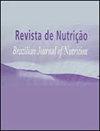巴西青少年和年轻人矿物质摄入不足的患病率及相关指标
IF 0.5
4区 医学
Q4 NUTRITION & DIETETICS
Revista De Nutricao-brazilian Journal of Nutrition
Pub Date : 2023-05-19
DOI:10.1590/1678-9865202336e220123
引用次数: 0
摘要
摘要目的了解15-24.9岁人群中钙、铁、锌、镁、磷、钠摄入不足的患病率及相关因素。方法:我们分析了来自巴西营养与健康研究的476名个体,将其分为两个年龄组(15-18.9岁的青少年和19-24.9岁的年轻人)。矿物质摄入量通过两次24小时膳食回顾获得。估计平均需要量和可容忍的最高摄入量的值被认为是计算不足的流行程度。采用多元逻辑回归确定与矿物质摄入量相关的因素。结果钙镁含量不足的发生率在男女、年龄组中均最高,达83%。大多数研究人群的钠摄入量高于可耐受的最高摄入量(>68%)。两年龄组各矿物质的摄取量在两性间存在差异(p0.05)。与矿物质摄入相关的因素是性别(钙、铁、磷和钠)、年龄组(钙、镁、磷和钠)和体力活动(钙、铁和镁),其次是社会经济水平(锌和钠)和体重状况(铁和钠)。结论研究人群的表达部分存在钙、镁、钠的营养风险。这些数据有助于修订与微量营养素摄入和青少年和年轻人养成更健康的习惯有关的国家公共政策。本文章由计算机程序翻译,如有差异,请以英文原文为准。
Prevalence of inadequacy and associated indicators with mineral intake in Brazilian adolescents and young adults
ABSTRACT Objective To describe the prevalence of inadequate mineral intake and associated factors with calcium, iron, zinc, magnesium, phosphorus, and sodium intakes in individuals aged 15-24.9 years. Methods We analyzed 476 individuals from the Brazilian Study of Nutrition and Health, stratified into two age groups (adolescents aged 15-18.9 years and young adults aged 19-24.9 years). Mineral intake was obtained from two 24-hour Dietary Recalls. The values of the Estimated Average Requirement and the Tolerable Upper Intake Levels were considered to calculate the prevalence of inadequacy. Multiple logistic regression was used to determine associated factors with mineral intake. Results Calcium and magnesium had the highest prevalence of inadequacy (>83%) in both sexes and age groups. Sodium intake was above Tolerable Upper Intake Levels for the majority of the population studied (>68%). The intake of all minerals was different between the sexes for the two age groups (p<0.01), and it was not different between age groups (p>0.05). The associated factors with mineral intake were sex (calcium, iron, phosphorus, and sodium), age group (calcium, magnesium, phosphorus, and sodium), and physical activity (calcium, iron, and magnesium), followed by socioeconomic level (zinc and sodium) and body weight status (iron and sodium). Conclusion The expressive portion of the studied population is at nutritional risk for calcium, magnesium, and sodium. Such data can contribute to the national public policy revision that is related to micronutrient intake and the adoption of healthier habits by adolescents and young adults.
求助全文
通过发布文献求助,成功后即可免费获取论文全文。
去求助
来源期刊
CiteScore
1.20
自引率
12.50%
发文量
24
审稿时长
6-12 weeks
期刊介绍:
Revista de Nutrição is former Revista de Nutrição da Puccamp, founded in 1988. It is a bimonthly publication every four months and it is of responsibility of the Centro de Ciências da Vida, da Pontifícia Universidade Católica de Campinas . It publishes articles that contribute to the study of Nutrition in its many sub-areas and interfaces; and is open to contributions of the national and international scientific communities.

 求助内容:
求助内容: 应助结果提醒方式:
应助结果提醒方式:


